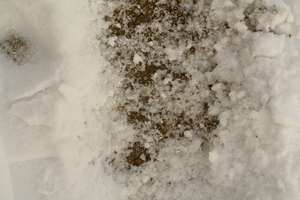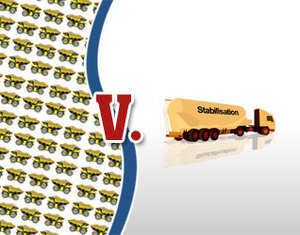Benefits of Soil Stabilisation
Stabilising soils with binders is now an extremely cost effective method of converting poor quality soil into a strong impermeable medium. This enables production of pavements, embankments, reinforced earth structures, railways, bulk fill applications, housing and industrial units in areas where they were not previously economically viable. Many years experience has proved the effectiveness of this method. This, combined with rising costs of conventional civil engineering, has transformed soil stabilisation into the most cost effective method of preparing sites for all construction projects.

Saves Money
You can usually save significant sums of money by soil stabilisation compared to the traditional "dig and dump" method. Dig and dump incurs the cost of vehicle movement, landfill tax and buying aggregates.
Savings by Design
Soils treated binders can be designed to be stronger than conventional granular sub base. Using this type of material in a pavement or foundation means that the strength is considerably enhanced. This strength can be used to reduce the thickness of the foundation or the thickness of the subsequent layers. Concrete or blacktop can be laid directly onto stabilised soil. Savings in granular sub base, concrete and bituminous materials are all possible.
Saves Time
Soil stabilisation can often shortens the time taken to complete a project by minimising the site preparation time and reducing tipping or import . The process also enables wet ground to be dried and strengthened for immediate use.

Winter Working
Soil stabilisation, using lime is without doubt the most effective way of drying a wet site. The addition of quicklime instantly dries up wet soils and allows extended working in wet conditions and into the winter. Ideal for haul roads and those difficult sites.

Saves Environmental Impact
Imagine removing 50 lorry loads of soil and bringing in 50 loads of imported material. One 30 tonne load of binder can eliminate these 100 vehicle movements. Less cost, less congestion and no furious neighbours. An environmental solution with many benefits.

Saves Waste
There is no need to import new material when the soil on site can be used after a simple treatment process. Even Type 1 sub base is not required as the same strength and properties can be achieved using the soils on site. Costly and time-consuming importation of new material and generation of large quantities of waste is therefore eliminated.

Saves Landfill Taxes
Soil stabilisation uses the soils available on your site. These are improved to give the properties required for construction. This can vary from a simple process to enable use in landscaping or embankments right through to use in sub base. All the available soils can be used, so tipping is virtually eliminated. No need for any more tipping charges, just stabilise the soils on site and use them.

